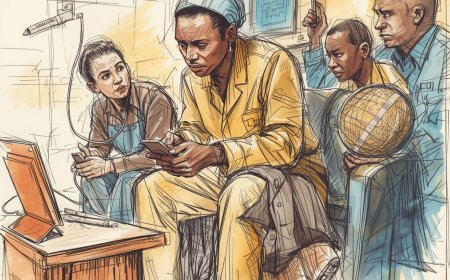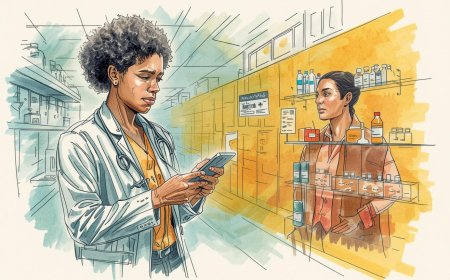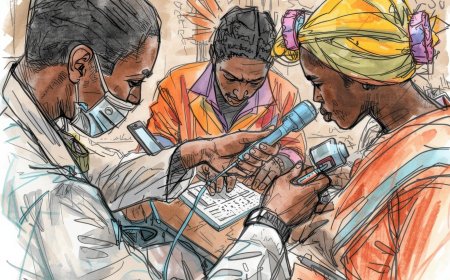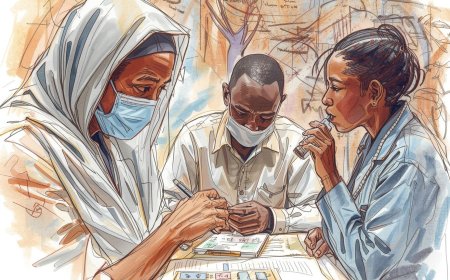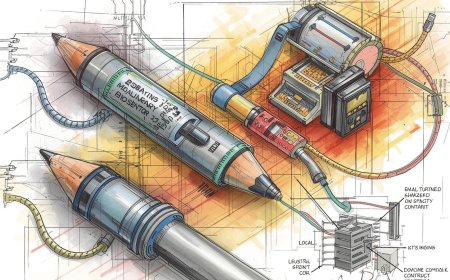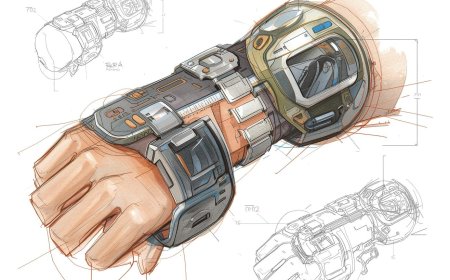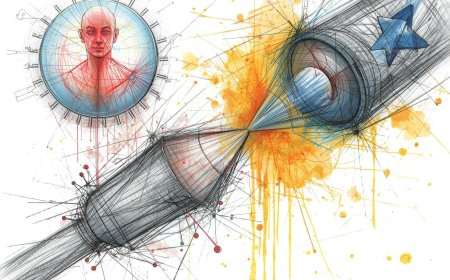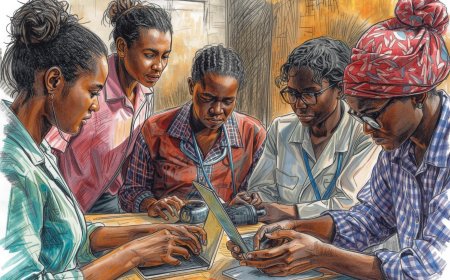How AI + Portable Imaging Can Extend Radiology Capacity in District Hospitals
This feature article examines how portable imaging devices (POCUS, ultra-portable X-ray) combined with AI and open-source infrastructure are expanding radiology capacity at district hospitals — with practical, Africa-focused case studies, implementation guidance, and curated tools/resources.

Abstract
District hospitals in low- and middle-income settings frequently lack timely access to diagnostic imaging and radiology expertise. Portable imaging (especially point-of-care ultrasound and ultra-portable digital X-ray) together with AI-assisted interpretation, tele-guidance, and open-source image management can dramatically extend diagnostic capacity where radiologists and fixed imaging suites are scarce. This feature article synthesizes recent evidence and real-world deployments from Africa, outlines practical implementation pathways for district hospitals, and curates vendor, software and training resources to support scale-up. (Word count: 150)
Introduction — the problem at district level
In many district hospitals across sub-Saharan Africa and other low-resource regions, clinicians must make high-stakes decisions without rapid imaging or specialist interpretation. WHO and global reviews highlight that limited access to basic modalities (radiography and ultrasound), shortages of trained personnel, and gaps in policies and infrastructure constrain diagnosis and increase referrals and delays. World Health Organization+1
Bridging this gap is not just a technical problem: it is operational (workflows, maintenance), educational (training non-radiologists), and regulatory (radiation safety, AI governance). This article describes how a combined approach — portable hardware, AI models for triage/interpretation, tele-guidance and open-source image infrastructure — can be applied to district hospitals, using Africa as the primary context for real-world examples and pilots. The Lancet+1
What technologies are we talking about?
-
Point-of-care ultrasound (POCUS) — handheld ultrasound probes that connect to a phone/tablet and can be used at bedside for obstetrics, trauma, cardiac, lung, and abdominal exams. These devices are low-cost relative to fixed scanners and amenable to task-shifting. PMC+1
-
Ultra-portable digital X-ray — battery-powered, mobile radiography units (some integrated with AI) for chest imaging and basic radiography; useful for TB screening, trauma and chest disease triage. Health Business+1
-
AI assistance & decision support — deep learning models that pre-read chest X-rays (triage for TB, pneumonia) or guide ultrasound image acquisition and measurements (e.g., gestational age). AI can reduce turnaround time and flag urgent findings for remote review. Qure AI+1
-
Teleradiology + open-source PACS/DICOM systems — low-cost servers and web viewers (Orthanc, DCM4CHEE, Weasis, OpenMRS integrations) to store, view and share imaging studies for remote specialist interpretation and QA. orthanc-server.com+1
Strong evidence and real-world deployments (case studies)
1. Kenya — Large O-POCUS rollout and Butterfly device deployments
A large obstetric POCUS program implemented across multiple Kenyan counties trained hundreds of providers and deployed handheld ultrasound units as part of a maternal health strengthening initiative; evaluations reported improved access to basic obstetric imaging and strengthened antenatal care services. Butterfly Network itself has documented large deployments in Kenya and South Africa (several hundred devices), and partnerships with local distributors (e.g., Ilara Health) have enabled clinics and micro-clinics to use handheld probes plus teleguidance for remote support. BioMed Central+2Butterfly Network+2
Practical lesson: pairing devices with structured training and remote QA increases uptake and clinical impact (fewer unnecessary referrals; earlier detection of complications). BioMed Central
2. AI for TB screening — Qure.ai and mobile X-ray
AI models (e.g., qXR/qTrack by Qure.ai) have been used in TB screening campaigns and mobile units, enabling real-time triage of chest X-rays and shortening the time to diagnosis in remote and outreach settings. Several pilot projects and scale-ups have taken place across low-resource settings and tribal/remote communities; partnerships with ministries and NGOs supported screening campaigns. Qure AI+1
Practical lesson: AI-enabled chest X-ray is most powerful as a triage/rapid-screening tool that triggers confirmatory tests (e.g., GeneXpert) and focused referral pathways.
3. National scale moves — Kenya’s AI X-ray rollouts (2024–2025)
Recent national programs have sourced ultra-portable AI-enabled X-ray units for TB and lung disease screening; one Kenyan rollout publicly reported distribution of dozens of AI-driven X-ray machines to counties as part of integrated screening programs. These initiatives show government-level buy-in is achievable when AI tools are framed as pragmatic screening accelerators. mygov.go.ke+1
4. Open-source PACS and teleradiology in LMIC settings
Open-source systems (Orthanc, dcm4chee, Weasis) have been documented as feasible building blocks for low-cost PACS and tele-imaging setups, enabling district hospitals to archive and share DICOM images and to connect with regional specialists or academic centers for interpretation and QA. Case studies and implementation guides exist showing workable integrations with EMRs like OpenMRS. PMC+1
Practical implementation pathway for a district hospital
Below is a pragmatic, phased model you can adapt.
Phase 0 — Prepare & assess
-
Needs assessment: typical case-mix (obstetrics, trauma, TB), referral times, internet/connectivity map.
-
Stakeholder alignment: hospital leadership, Ministry/regulator, regional radiology support.
Phase 1 — Pilot deployment (3–6 months)
-
Acquire 1–2 handheld ultrasound units and 1 ultra-portable digital chest X-ray (if TB/high chest burden). Consider devices with offline capability and battery operation. PMC+1
-
Install an open-source PACS (Orthanc / dcm4chee) on a low-cost server to archive DICOM and share studies. orthanc-server.com+1
-
Train a small group (doctors, clinical officers, midwives) with blended learning + hands-on; institute tele-mentoring and QA via remote radiologists or POCUS mentors. BioMed Central+1
Phase 2 — Scale & integrate
-
Expand devices, integrate imaging order workflows into the EMR (OpenMRS/Bahmni), and add AI triage for chest X-rays where appropriate to reduce turnaround. OpenMRS Talk+1
-
Build metrics: time-to-diagnosis, referrals avoided, test accuracy, maternal/neonatal outcomes for OB POCUS.
Phase 3 — Sustain & govern
-
Maintenance plan, spare parts, local power solutions.
-
Governance: radiation safety, AI oversight, data privacy, and local regulatory approvals. U.S. Food and Drug Administration+1
Common challenges — and mitigations
-
Training & skill retention: blended curricula + remote QA and certification programs (POCUS academies, MSF resources) improve retention. pocus.org+1
-
Data & connectivity constraints: devices that work offline + store-and-forward teleradiology workflows reduce dependence on continuous connectivity. Frontiers
-
Regulatory & safety concerns: follow WHO/ national radiology guidance and FDA/IAEA radiation safety rules; define clear scope of practice for non-radiologists. WHO Apps+1
-
AI bias & governance: ensure local validation of AI models, and implement oversight and human-in-the-loop processes. Several governance frameworks and policy briefs for AI in African health contexts are now available. scienceforafrica.foundation
Key metrics to monitor
-
Number of scans performed per 1000 outpatient visits
-
Turnaround time (scan → action/referral)
-
Referral avoidance (percent of patients managed locally because of imaging)
-
Clinical outcomes (e.g., antenatal complication detection rates, TB detection yield)
-
Image quality and QA pass rates from remote radiologists
Curated & Categorized Online Resources, Tools, Guides & Platforms (with working URLs)
Devices & Vendors (hardware + vendor case studies)
-
Butterfly Network — device pages, case studies (Butterfly iQ / iQ+; Africa deployments). https://www.butterflynetwork.com/case-studies-1000-probes. Butterfly Network+1
-
Ilara Health — African diagnostic devices distributor and clinic support (partners with Butterfly). https://www.ilarahealth.com/. Ilara Health
-
Qure.ai — AI for chest X-ray (qXR, qTrack) and TB screening resources. https://www.qure.ai/. Qure AI
Open-source image infrastructure & teleradiology
-
Orthanc (open-source DICOM server / PACS): https://www.orthanc-server.com/. orthanc-server.com
-
dcm4chee-arc (open PACS archive) / Weasis viewer — integration guides and community docs. https://weasis.org/en/getting-started/dcm4chee/. weasis.org
-
OpenMRS radiology module & community discussions (EMR-PACS integration): https://openmrs.atlassian.net/wiki/spaces/docs/pages/25501855/Radiology%2BModule. openmrs.atlassian.net
Training, curriculum & implementation guides
-
WHO — Strengthening Medical Imaging (program pages & documents). https://www.who.int/activities/strengthening-medical-imaging. World Health Organization
-
IFEM — POCUS curriculum guidelines: https://www.ifem.cc/point_of_care_ultrasound_curriculum_guidelines. ifem.cc
-
MSF Tembo POCUS facilitator training resources: https://tembo.msf.org/course/info.php?id=534. tembo.msf.org
Evidence, research & case studies
-
BMC — Large evaluation of obstetric point-of-care ultrasound program (Kenya multicounty program). Githemo et al., BMC Health Serv Res (2025). https://bmchealthservres.biomedcentral.com/articles/10.1186/s12913-025-13212-8. BioMed Central
-
PMC — Evaluation of handheld POCUS in African EDs (Burleson et al., 2020). https://pmc.ncbi.nlm.nih.gov/articles/PMC7721766/. PMC
Policy, governance & AI
-
Science for Africa Foundation — Governance of AI for Global Health in Africa (policy brief). https://scienceforafrica.foundation/sites/default/files/2025-04/Governance%20of%20AI%20for%20Global%20Health%20in%20Africa%20v3.pdf. scienceforafrica.foundation
Implementation toolkits & community
-
Orthanc download & docs (technical install guides for small hospitals): https://www.orthanc-server.com/download.php. orthanc-server.com
-
OpenMRS community threads and examples for PACS integrations: https://talk.openmrs.org/. OpenMRS Talk
(Tip: bookmark these pages, and when setting up procurement or pilots, request device demos, local maintenance contracts, and demo datasets for AI validation in your patient population.)
Recommendations for funders, health managers and clinicians
-
Fund integrated pilots, not hardware only. Combine devices + training + PACS + QA + connectivity. Evidence from Kenya and other pilots shows training and mentoring are the multiplier. BioMed Central+1
-
Validate AI locally. Before full reliance, test AI models on local patient images and workflows; monitor for false positives/negatives. PMC+1
-
Adopt open standards & open-source for sustainability. Orthanc/dcm4chee and OpenMRS integrations reduce vendor lock-in and lower running costs. PMC+1
-
Build regulatory & governance pathways early. Address radiation safety, data protection, and AI oversight during pilot design. WHO Apps+1
Conclusion
Portable imaging + AI + tele-support is not futuristic — it is already reshaping district-level diagnostics across Africa. Successful scale-up requires careful attention to training, infrastructure, governance, and human-in-the-loop validation. With pragmatic pilots and open-source infrastructure, district hospitals can deliver faster, safer, and more equitable diagnostic care — reducing unnecessary referrals, improving maternal and infectious disease outcomes, and placing useful imaging back into the hands of frontline clinicians. BioMed Central+2Qure AI+2
References
Note: URLs are included for direct access to the referenced project pages and articles.
-
Githemo, G., et al. (2025). Evaluation of large-scale implementation of obstetric point-of-care ultrasound (O-POCUS). BMC Health Services Research. https://bmchealthservres.biomedcentral.com/articles/10.1186/s12913-025-13212-8. BioMed Central
-
Burleson, S. L., et al. (2020). Evaluation of a novel handheld point-of-care ultrasound device in an African emergency department. Western Journal / PMC. https://pmc.ncbi.nlm.nih.gov/articles/PMC7721766/. PMC
-
Butterfly Network. (2022–2025). Butterfly iQ deployments and case studies (Kenya, South Africa). Butterfly Network case study pages. https://www.butterflynetwork.com/case-studies-1000-probes. Butterfly Network+1
-
Qure.ai. (n.d.). qXR/qTrack – AI for chest X-ray and TB screening. https://www.qure.ai/. Qure AI
-
World Health Organization. (2025). Strengthening medical imaging. https://www.who.int/activities/strengthening-medical-imaging. World Health Organization
-
Ghaderi, H., et al. (2023). Assessing available open-source PACS options. Journal / PMC. https://pmc.ncbi.nlm.nih.gov/articles/PMC10584756/. PMC
-
Science for Africa Foundation. (2025). Governance of AI for Global Health in Africa. https://scienceforafrica.foundation/sites/default/files/2025-04/Governance%20of%20AI%20for%20Global%20Health%20in%20Africa%20v3.pdf. scienceforafrica.foundation
-
WHO. (2012). The WHO manual of diagnostic imaging: radiographic. https://www.who.int/publications/i/item/9241545550. World Health Organization
What's Your Reaction?
 Like
0
Like
0
 Dislike
0
Dislike
0
 Love
0
Love
0
 Funny
0
Funny
0
 Angry
0
Angry
0
 Sad
0
Sad
0
 Wow
0
Wow
0















